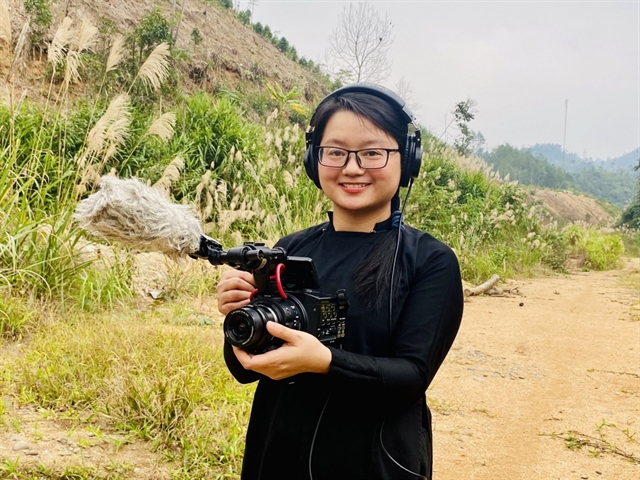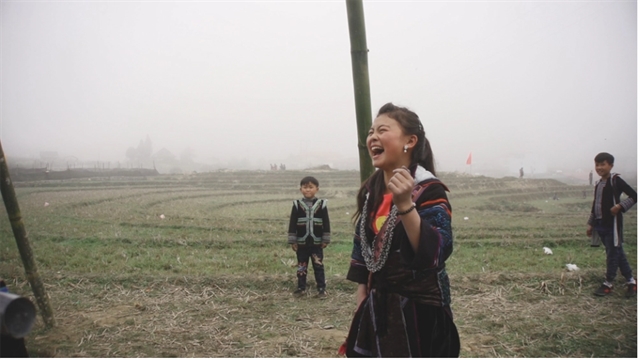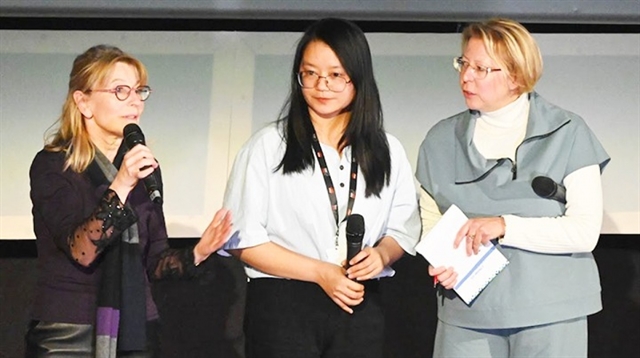 Sunday/Weekend
Sunday/Weekend

 |
| Director Hà Lệ Diễm. Photo vov.vn |
Children Of The Mist (Những Đứa Trẻ Trong Sương), a documentary directed by Hà Lệ Diễm, has had an "unprecedented" number of views since debuting in the country.
The film has attracted the attention of audiences nationwide since it was shortlisted for the 2023 Oscars, joining an exclusive list of 15 exceptional documentaries. It also won the Best International Film award at the Docaviv Film Festival, and the Best Director award at the Amsterdam Documentary Film Festival in 2021.
The film's success can be attributed to its appealing characters and setting, and dark edge.
 |
| A scene of Di in 'Children Of The Mist'. Photo courtesy of Varan Việt Nam |
Film critic Guy Lodge from Variety praised the director for skilfully handling a delicate subject and vulnerable young women.
Lodge said: “It’s an auspicious arrival for first-time feature director Diễm, who handles delicate subject matter (not to mention vulnerable human subjects) with a frankness that stops short of button-pushing. That tact is crucial in a film operating as both close-quarters character study and wider ethnographic portrait, offering a rare, dedicated view of Việt Nam’s little-represented Hmong [the Mông ethnic minority] population.”
“Diễm finds a measure of sympathy for all parties in this situation, variously torn between life as they’ve always known it and the onset of more contemporary gender politics that are at once freeing and disorienting."
.jpg) |
| Di and Vang 'the groom'. Photo courtesy of New Directors/New Films/Maelle Guenegues |
The film explores the clash between traditional customs and education through the story of an ethnic Mông teenage girl named Di in the northern province of Lào Cai.
Di is one of the first generations of children to receive a formal education. Her bubbly personality and mischievousness dominate the screen and capture the audience’s hearts.
Diễm, 31, said she chose this topic to make the film after having spent most of her time living with the Mông family before deciding to film their life.
“Initially, I just wanted to capture their day-to-day routine, but it soon became clear to me that this type of content might become monotonous. Therefore, I decided to switch to a different approach," she said.
"The turning point came when I stumbled upon Di and her friends while they were playing the 'bride-kidnapping' game, a longstanding Mông tradition where boys 'kidnap' their future wives during the Lunar New Year celebrations. It was then that I realised that this was the perfect opportunity to capture a unique aspect of Mông culture that is often overlooked.”
 |
| Director Hà Lệ Diễm (centre) at Tournai Ramdam 2023 film festival. Photo courtesy of Jeanne-Marie Vanderưinkel |
The film deals with the clash between education and the traditional Mông customs, where young girls are often forced into marriage and do most of the household and farming work. This especially affects the main subject - Di when she is shown to be torn between the desire for education and personal growth and the pressure to conform to traditional gender norms.
One of the most poignant moments in the film is when Di's mother calls her on the phone the first time she runs away with a strange boy, her voice filled with emotion, expressing her love for her daughter in a way that she rarely shows otherwise.
Through tears, she confesses how much she misses Di and muses on how she would cope with it without her around to take care of the cattle when she goes out drinking. At that moment, all the bickering and arguments that are common between them seem insignificant, and the depth of their connection becomes apparent.
As the conversation continues, Di's mother imparts a piece of advice to her daughter, cautioning her not to fall for smooth-talking men as she had done in the past. It is a tender and loving gesture, as her mother desperately tries to protect her daughter from any harm, even though she knows she cannot always be there for her.
The weight of the moment is palpable, and the audience is left feeling the raw emotion of a mother's love and the heartbreak of a daughter's difficult circumstances.
The intensity of the film reaches its peak as Di is dragged away for the second time, with her screams and cries filling the air. The sound of her desperation and helplessness is deeply distressing, creating an atmosphere of profound trauma.
With her fly-on-the-wall approach, the director fully documents the gut-wrenching scene when the groom's family forcefully take Di away. While the girl is being dragged, kicking and screaming, she cries out for Diễm's help.
Diễm did not expect the custom to be so brutal.
“Despite having rehearsed the 'bride-kidnapping' scene for a week beforehand, when Di was kidnapped by the groom's family, a sense of terror washed over me, and I felt powerless to control myself. The harrowing scene was etched in my mind, its brutality too much to bear, and I tried desperately to intervene and come to Di's rescue, but my efforts were futile, as I am not strong enough," Diễm said.
The documentary is a must-watch for anyone interested in gender, culture and tradition. It offers a rare insight into the Mông people's lives, highlighting the urgent need for education and empowerment for young girls in marginalised communities.
At 92 minutes long, the film is an emotional and thought-provoking journey, and it will leave you with a deep appreciation of the resilience and strength of the human spirit. VNS